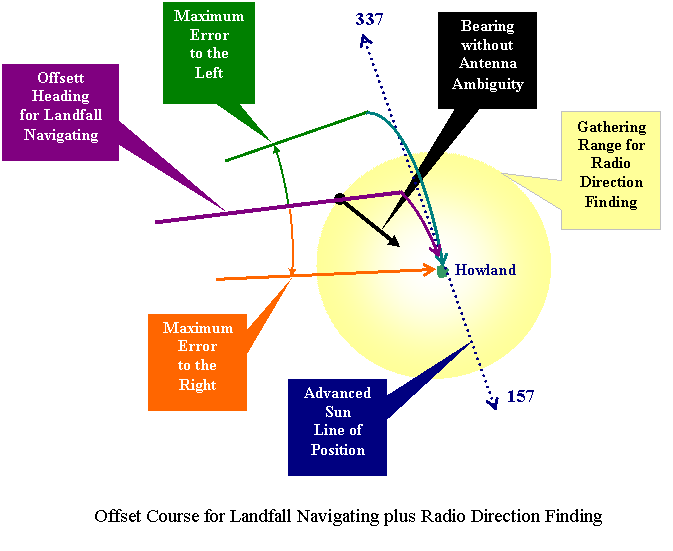|
Copyright ©2010 by Paul Niquette. All rights reserved. |
||
 The
diagram below is schematic in nature, such that all
distances are left unspecified. It depicts a
realistic case pertinent to the final phase of the
Lae-to-Howland flight. An offset heading has
been prescribed by Fred Noonan to the left of course as
a conventional strategy for mitigating navigation
errors. The
diagram below is schematic in nature, such that all
distances are left unspecified. It depicts a
realistic case pertinent to the final phase of the
Lae-to-Howland flight. An offset heading has
been prescribed by Fred Noonan to the left of course as
a conventional strategy for mitigating navigation
errors.
The most extreme navigation error to the left is shown missing the gathering range. However, upon reaching the sun line-of-position, Amelia Earhart would be advised by Fred Noonan to turn with confidence to the right and onto a course of 157 degrees. The expectation -- indeed, as it turned out, only the hope -- would be that eventually the Electra would come within gathering range and successfully complete the flight using RDF.
For our solution, then, we offer the
following answers to the question in the puzzle: "What could
possibly go wrong?"
As we know now, RDF did not work for the flight. In the final stages of the search for Howland, the Electra was flying in clear skies at 1,000 feet, scanning the horizon for Itasca with a smoke stack of, say, 40 feet above the waterline. The visibility limit was 47 miles using this formula... Visibility
Limit = (2 R h1 + h12)1/2 + (2 R h2 + h22)1/2,
where… Rejection by Earhart of Noonan's final heading is controversial. But not unprecedented...
Noonan offset the prescribed heading 4o to the left of the direct course from Natal
to Dakar, a distance of 1,400 miles. At that
distance, the nominal landfall intersection with the
coast of Africa would be displaced less than 100
miles. Upon arrival over the coast of Africa,
landfall navigation called for a turn to the
south. However, not able to confirm charted
objects on the coast-line, Earhart decided to turn
north instead. Long
described the result this way (p.143)...
In 20 minutes, they landed -- not at
Dakar -- but at St. Louis in French West Africa, 120
miles north of Dakar. No such outcome was
possible on July 2, 1937.
|
